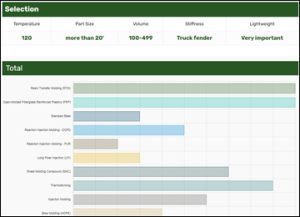Three Common Reinforcing Materials for Plastics
August 16, 2024Have you ever thought about making the switch to plastic for your equipment parts? Compared to some materials, like metal, plastic is known for its longevity, helps decrease costly replacements, and reduces lost productivity that can come with making frequent repairs.
At Osborne, we create plastic products custom-molded for your specific equipment needs. One of the first steps in creating a custom-molded plastic part is considering how the product will be used so that the right material and molding process can be selected. Factors like heat resistance, strength, stiffness, and impact resistance can be tailed to the part’s specific use so that your product remains durable over time and maintains a long lifespan.
If you have ever considered custom plastics, but aren’t sure where to begin or what your options are, our material selection tool and process comparison tool can help you get started.
Material Selection Tool
 When selecting the right material for your part, there are a handful of factors to consider. With our new material selection tool, a step-by-step series of considerations are presented that can help you determine the right material and process for your new project.
When selecting the right material for your part, there are a handful of factors to consider. With our new material selection tool, a step-by-step series of considerations are presented that can help you determine the right material and process for your new project.
First, what kind of temperatures will your part or product be exposed to over its lifetime? This could range from extreme cold (minus 40 degrees Fahrenheit) to extreme heat (320 degrees Fahrenheit). For this question, we want you to choose the most extreme temperature that the product could experience. This helps us know if the material needs to be resistant to cold or heat.
For the second question, we dive into size. More specifically, the largest dimension for the part. If the measurement is approximately 20 feet by 10 feet by 5 feet, you’ll need to select “20 feet” in the dropdown menu.
Next, how many production parts will you need annually? For this dropdown, select the option that best fits your volume needs, which can range from fewer than 99 to more than 100,000 pieces.
Question four deals with part flexibility. All materials fail after a certain amount of pressure is applied, but some are much stronger than others. Options range from extremely flexible like a seat cushion or a rubber sole to more rigid like hardwood flooring or porcelain.
Lastly, how important is it that your part is lightweight? For this question, we want you to consider the importance of its weight to the other four factors involved: temperature, size, volume and stiffness. If the other factors are far more important than how light it is, then select “not important.” If weight trumps the other requirements, select “very important.” If all characteristics are about the same level of importance, you can select “somewhat important.”
Once you’ve made your selections and clicked “show results,” the tool displays which material is most suitable for your requirements from 0 to 100 percent compatibility levels.
Process Comparison Tool
 Another tool now available to aid in determining the right process for your molding project is our process comparison tool. This tool compares two molding processes, outlining various features, capabilities, requirements and more.
Another tool now available to aid in determining the right process for your molding project is our process comparison tool. This tool compares two molding processes, outlining various features, capabilities, requirements and more.
Process options with the new comparison tool include:
- Reaction injection molding with DCPD
- Reaction injection molding with polyurethane
- Long fiber injection
- Resin transfer molding
- Vacuum infusion
- Pultrusion
- Compression molding
- Injection molding
- Blow molding
- Rotational molding
- Hand lay-up
- Spray-up
- 3D printing
Selecting processes from the dropdown menu will allow you to compare composition, process capabilities, material capabilities, tooling requirements, and advantages and disadvantages.
Let’s say, for example, you want a custom-molded plastic part made but you can’t decide between reaction injection molding (RIM) and thermoplastic injection molding. Using the tool, you can see that while injection molding is better suited for high volumes, its mold cost compared to RIM is higher, and it isn’t suitable for very large parts. Important advantages and disadvantages for both are also displayed that can help you consider which process is best.
You can make unlimited process comparisons using the tool, so don’t be afraid to continue evaluating until you fully understand your options. We created these tools to give you a better idea of the material options and processes available to you, whether that be from us or another manufacturer.
If you’re still on the fence after diving into the tools, let us help you decide if a custom-molded plastic product is right for you. Contact us today.


